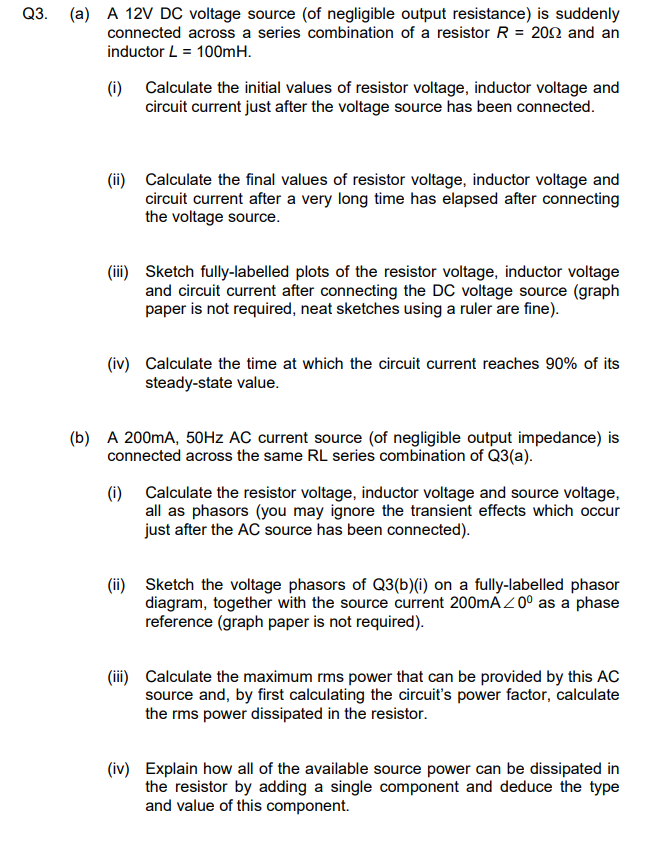(iv) Explain how all of the available source power can be dissipated in the resistor by adding a single component and deduce the type and value of this component.
(iv) Explain how all of the available source power can be dissipated in the resistor by adding a single component and deduce the type and value of this component.
Introductory Circuit Analysis (13th Edition)
13th Edition
ISBN:9780133923605
Author:Robert L. Boylestad
Publisher:Robert L. Boylestad
Chapter1: Introduction
Section: Chapter Questions
Problem 1P: Visit your local library (at school or home) and describe the extent to which it provides literature...
Related questions
Question
Q3-b- part iv)
thanks

Transcribed Image Text:Q3.
(a) A 12V DC voltage source (of negligible output resistance) is suddenly
connected across a series combination of a resistor R = 2002 and an
inductor L = 100mH.
(i) Calculate the initial values of resistor voltage, inductor voltage and
circuit current just after the voltage source has been connected.
(ii) Calculate the final values of resistor voltage, inductor voltage and
circuit current after a very long time has elapsed after connecting
the voltage source.
(iii) Sketch fully-labelled plots of the resistor voltage, inductor voltage
and circuit current after connecting the DC voltage source (graph
paper is not required, neat sketches using a ruler are fine).
(iv) Calculate the time at which the circuit current reaches 90% of its
steady-state value.
(b) A 200mA, 50Hz AC current source (of negligible output impedance) is
connected across the same RL series combination of Q3(a).
(i) Calculate the resistor voltage, inductor voltage and source voltage,
all as phasors (you may ignore the transient effects which occur
just after the AC source has been connected).
(ii) Sketch the voltage phasors of Q3(b)(i) on a fully-labelled phasor
diagram, together with the source current 200mA/0° as a phase
reference (graph paper is not required).
(iii) Calculate the maximum rms power that can be provided by this AC
source and, by first calculating the circuit's power factor, calculate
the rms power dissipated in the resistor.
(iv) Explain how all of the available source power can be dissipated in
the resistor by adding a single component and deduce the type
and value of this component.
Expert Solution
This question has been solved!
Explore an expertly crafted, step-by-step solution for a thorough understanding of key concepts.
Step by step
Solved in 4 steps with 4 images

Knowledge Booster
Learn more about
Need a deep-dive on the concept behind this application? Look no further. Learn more about this topic, electrical-engineering and related others by exploring similar questions and additional content below.Recommended textbooks for you

Introductory Circuit Analysis (13th Edition)
Electrical Engineering
ISBN:
9780133923605
Author:
Robert L. Boylestad
Publisher:
PEARSON

Delmar's Standard Textbook Of Electricity
Electrical Engineering
ISBN:
9781337900348
Author:
Stephen L. Herman
Publisher:
Cengage Learning

Programmable Logic Controllers
Electrical Engineering
ISBN:
9780073373843
Author:
Frank D. Petruzella
Publisher:
McGraw-Hill Education

Introductory Circuit Analysis (13th Edition)
Electrical Engineering
ISBN:
9780133923605
Author:
Robert L. Boylestad
Publisher:
PEARSON

Delmar's Standard Textbook Of Electricity
Electrical Engineering
ISBN:
9781337900348
Author:
Stephen L. Herman
Publisher:
Cengage Learning

Programmable Logic Controllers
Electrical Engineering
ISBN:
9780073373843
Author:
Frank D. Petruzella
Publisher:
McGraw-Hill Education

Fundamentals of Electric Circuits
Electrical Engineering
ISBN:
9780078028229
Author:
Charles K Alexander, Matthew Sadiku
Publisher:
McGraw-Hill Education

Electric Circuits. (11th Edition)
Electrical Engineering
ISBN:
9780134746968
Author:
James W. Nilsson, Susan Riedel
Publisher:
PEARSON

Engineering Electromagnetics
Electrical Engineering
ISBN:
9780078028151
Author:
Hayt, William H. (william Hart), Jr, BUCK, John A.
Publisher:
Mcgraw-hill Education,